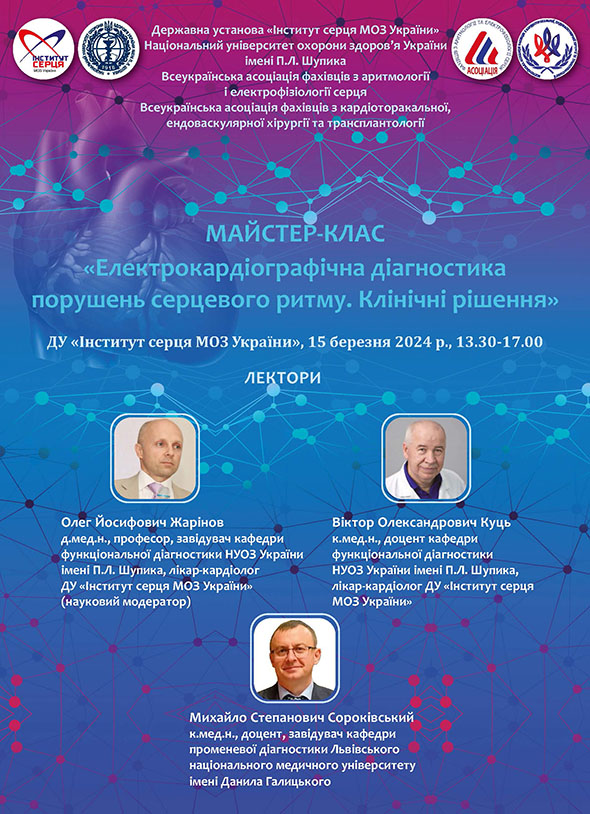Небезпечні перфорації коронарних артерій під час перкутанних коронарних втручань
H.C. Ramesh, R. Varadaraju, M. Chandrasena, P.K. Sunil, A. Cherukumudi
Література
- Al-Lamee AR, Ielasi A, Latib A, et al. Incidence, predictors, management, immediate and long-term outcomes following grade III coronary perforation. JACC Cardiovasc Interv. 2011;4:87e95.
- Celiento M, Scioti G, Pratali S, et al. Repair of coronary artery perforation following angioplasty using TachoSil patches. Interactive Cardio Vascular and Thorac Surg. 2010;10:328–30.
- Ellis SG, Ajluni S, Arnold AZ, et al. Increased coronary perforation in the new device era: incidence, classification, management, and outcome. Circulation. 1994;90:2725–30.
- Fukui T, Takanashi S, Mihara W, et al. Coronary endarterectomy and stent removal after iatrogenic perforation. Ann Thorac Surg. 2004;77(2):708–11. DOI:10.1016/S0003-4975(03)01424-3.
- Gasparini GL, Merella P, Mazzarotto P, Gagnor A, Garbo R, et al. Retrograde approach-related epicardial collateral channel perforation successfully treated with simultaneous bilateral coils embolization: a case illustration and review. Cardiovasc Revasc Med. 2018;19:879–86.
- Inoue Y, Ueda T, Taguchi S, et al. Teflon Felt Wrapping Repair for Coronary Perforation After Failed Angioplasty. Ann Thorac Surg. 2006;82:2312–4.
- Krishnegowda C, Puttegowda B, Krishnappa S, et al. Incidence, clinical and angiographic characteristics, management and outcomes of coronary artery perforation at a high volume cardiac care center during percutaneous coronary intervention. Indian Heart J. 2020;72(4):232–8. https://doi.org/10.1016/j.ihj.2020.07.012.
- Lemmert ME, Bommel RJ, Diletti R, et al. Clinical characteristics and management of coronary artery perforations: a single-center 11-year experience and practical overview. J Am Heart Assoc. 2017;6:e007049.
- Loubeyre C, Morice M-C, Berzin B, et al. Emergency coronary artery bypass surgery following coronary angioplasty and stenting. Results of a French multicenter registry. Catheter Cardiovasc Interv. 1999;48:441–8.
- Shimony A, Zahger D, Van Straten M, et al. Incidence, risk factors, management and outcomes of coronary artery perforation during percutaneous coronary intervention. Am J Cardiol. 2009;104:1674–7.
- Szczechowicz MP, Mkalaluh S, Torabi S, et al. Bailout bypass surgery for complications of coronary interventions. Asian Cardiovascular & Thorac Ann. 2020;28(4):205–12. DOI:10.1177/0218492320919200.
- Trana C, Muller O, Roguelov C, et al. Deciding on the best course of action for grade III coronary perforations. Interv Cardiol. 2011;3(3):321–7.
- Tumscitz C, Lanzillotti V, Pirani L, Di Cesare AM, Scoccia A, Gallo F. Type III coronary perforation during chronic total occlusion percutaneous coronary interventions treated with Cyanoacrylate glue embolization: case report and review of the technique. Vessel Plus. 2019;3:20.
- Verevkin A, Aspern K, Leontyev S, Lehmann S, et al. Early and Long-Term Outcomes in Patients Undergoing Cardiac Surgery Following Iatrogenic Injuries during Percutaneous Coronary Intervention. J Am Heart Assoc. 2019;8:e010940. DOI:10.1161/JAHA.118.010940.
| [PDF] | [Зміст журналу] |












